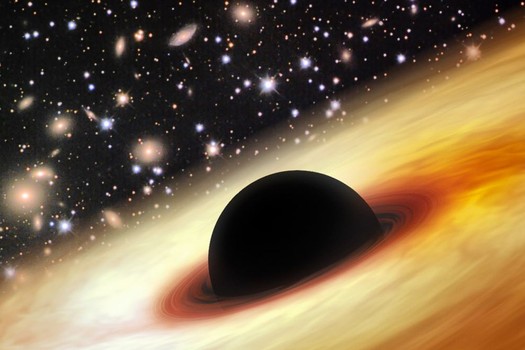A team of astronomers announced that they have found a supermassive black hole that is about 12 billion times more massive than the Sun and appears to have formed when the universe was only 875 million years old, or 6 percent of its current age. This is a surprising find because black holes are thought to grow relatively slowly by pulling in anything that gets too close, and 875 million years is a short period of time for such a massive black hole to form.
“How do you build such a big black hole in such a short time?” asks Xue-Bing Wu of China’s Peking University, lead author of the study. “This is quite surprising because it presents serious challenges to theories of black hole growth in the early universe.”
As even light cannot escape a black hole, they must be measured indirectly. The team did this by observing a quasar, or quasi-stellar radio source, which is formed when a large amount of matter forms an accretion disc around a black hole and emits an enormous amount of energy as it falls into the black hole. Telescopes in China, Hawaii, Arizona, and Chile were used by Wu and his colleagues.
Most major galaxies, including the Milky Way, are thought to have supermassive black holes in their centers. But only some have the hot, luminous accretion discs known as quasars surrounding them. The black hole at the center of the Milky Way only has a mass of 4.31±0.38 million solar masses, while the largest black holes found so far exceed 10 billion solar masses. The newly discovered object, known as SDSS J010013.021280225.8 (or J0100+2802 for short), is the most massive and luminous quasar yet observed.
“This is the biggest monster we’ve ever detected in terms of luminosity,” says Avi Loeb, chair of the Harvard astronomy department, who was not involved in the research. It’s about 40,000 times as bright as the entire Milky Way, Loeb says, or about 429 trillion times brighter than the Sun. The brightness of the quasar tells astronomers how much the gas is being heated, which tells them how massive the black hole powering the quasar is. “We’ve seen other quasars from this period,” says Wu, “but none of them has a mass of more than three billion times that of the sun.” About 40 other such quasars with a redshift greater than 6 have been discovered.
The object looks like an ordinary star at first glance, but analyzing the light in detail revealed both the unusual emission spectrum of a quasar as well as a redshift of 6.30. As much of the observable universe is redshifted, it is known that the universe is expanding. The farther away an object is, the greater the degree of redshift. A redshift of 6.30 corresponds to a time of about 13 billion years ago. When light takes so long to reach Earth, astronomers are looking at objects as they were when the universe was much younger.
How such a massive black hole formed so fast is a mystery. “It requires either very special ways to quickly grow the black hole or a huge seed black hole,” Wu told Space.com. Accretion discs limit the growth rate of a black hole. As large amounts of gas and dust approach the black hole, they can create a “traffic jam” that slows down other material that is falling in. Heat and radiation that results from these traffic jams forces matter away from the black hole. A recent study suggests that the denser gas which might have been present at the time could have obscured some of the heat and radiation as well as provide more fuel, thereby helping matter to fall into black holes at a faster rate. But this black hole is still too large to be explained by such an effect.
Another possibility is that two black holes combined as two galaxies collided. But this only works if the black holes are nearly equal in mass. Otherwise, the imbalance would eject the combined black hole from the new galaxy. Loeb suggests that as there is no theoretical upper limit on stellar mass, the earliest stars could have been much larger, hotter, and shorter-lived than any stars observed locally. This could jump-start the formation of a supermassive black hole, and this combined with the effects of denser gas could explain the quick formation of J0100+2802. It is not known whether such supermassive stars ever formed, but the James Webb Space Telescope, which is scheduled to go into orbit in 2018, might be able to answer that question.
The newly discovered object presents an opportunity to astronomers. As a quasar’s light travels to Earth, it passes through interstellar gas that colors the light. By analyzing the wavelengths of light which arrive at Earth, scientists can determine which elements make up the gas. This can provide information to cosmologists about the star formation processes in the early universe which produced those elements.
“This quasar is the most luminous one in the early universe, which, like a lighthouse, will provide us chances to use it as a unique tool to study the cosmic structure of the dark, distant universe,” Wu said.















